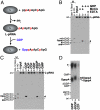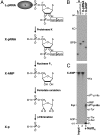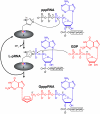Histidine-mediated RNA transfer to GDP for unique mRNA capping by vesicular stomatitis virus RNA polymerase
- PMID: 20142503
- PMCID: PMC2840475
- DOI: 10.1073/pnas.0913083107
Histidine-mediated RNA transfer to GDP for unique mRNA capping by vesicular stomatitis virus RNA polymerase
Abstract
The RNA-dependent RNA polymerase L protein of vesicular stomatitis virus, a prototype of nonsegmented negative-strand (NNS) RNA viruses, forms a covalent complex with a 5'-phosphorylated viral mRNA-start sequence (L-pRNA), a putative intermediate in the unconventional mRNA capping reaction catalyzed by the RNA:GDP polyribonucleotidyltransferase (PRNTase) activity. Here, we directly demonstrate that the purified L-pRNA complex transfers pRNA to GDP to produce the capped RNA (Gpp-pRNA), indicating that the complex is a bona fide intermediate in the RNA transfer reaction. To locate the active site of the PRNTase domain in the L protein, the covalent RNA attachment site was mapped. We found that the 5'-monophosphate end of the RNA is linked to the histidine residue at position 1,227 (H1227) of the L protein through a phosphoamide bond. Interestingly, H1227 is part of the histidine-arginine (HR) motif, which is conserved within the L proteins of the NNS RNA viruses including rabies, measles, Ebola, and Borna disease viruses. Mutagenesis analyses revealed that the HR motif is required for the PRNTase activity at the step of the enzyme-pRNA intermediate formation. Thus, our findings suggest that an ancient NNS RNA viral polymerase has acquired the PRNTase domain independently of the eukaryotic mRNA capping enzyme during evolution and PRNTase becomes a rational target for designing antiviral agents.
Conflict of interest statement
The authors declare no conflict of interest.
Figures





Comment in
-
Viruses know more than one way to don a cap.Proc Natl Acad Sci U S A. 2010 Feb 23;107(8):3283-4. doi: 10.1073/pnas.0915061107. Epub 2010 Feb 18. Proc Natl Acad Sci U S A. 2010. PMID: 20167804 Free PMC article. No abstract available.
Similar articles
-
5'-Phospho-RNA Acceptor Specificity of GDP Polyribonucleotidyltransferase of Vesicular Stomatitis Virus in mRNA Capping.J Virol. 2017 Feb 28;91(6):e02322-16. doi: 10.1128/JVI.02322-16. Print 2017 Mar 15. J Virol. 2017. PMID: 28053102 Free PMC article.
-
Signature motifs of GDP polyribonucleotidyltransferase, a non-segmented negative strand RNA viral mRNA capping enzyme, domain in the L protein are required for covalent enzyme-pRNA intermediate formation.Nucleic Acids Res. 2016 Jan 8;44(1):330-41. doi: 10.1093/nar/gkv1286. Epub 2015 Nov 23. Nucleic Acids Res. 2016. PMID: 26602696 Free PMC article.
-
The HR motif in the RNA-dependent RNA polymerase L protein of Chandipura virus is required for unconventional mRNA-capping activity.J Gen Virol. 2010 May;91(Pt 5):1311-4. doi: 10.1099/vir.0.019307-0. Epub 2010 Jan 27. J Gen Virol. 2010. PMID: 20107017 Free PMC article.
-
In vitro capping and transcription of rhabdoviruses.Methods. 2013 Feb;59(2):188-98. doi: 10.1016/j.ymeth.2012.05.013. Epub 2012 Jun 8. Methods. 2013. PMID: 22687619 Free PMC article. Review.
-
RNA Synthesis and Capping by Non-segmented Negative Strand RNA Viral Polymerases: Lessons From a Prototypic Virus.Front Microbiol. 2019 Jul 10;10:1490. doi: 10.3389/fmicb.2019.01490. eCollection 2019. Front Microbiol. 2019. PMID: 31354644 Free PMC article. Review.
Cited by
-
Biochemistry of the Respiratory Syncytial Virus L Protein Embedding RNA Polymerase and Capping Activities.Viruses. 2023 Jan 25;15(2):341. doi: 10.3390/v15020341. Viruses. 2023. PMID: 36851554 Free PMC article. Review.
-
Identification of aromatic amino acid residues in conserved region VI of the large polymerase of vesicular stomatitis virus is essential for both guanine-N-7 and ribose 2'-O methyltransferases.Virology. 2010 Dec 20;408(2):241-52. doi: 10.1016/j.virol.2010.09.017. Epub 2010 Oct 18. Virology. 2010. PMID: 20961592 Free PMC article.
-
Vesiculopolins, a New Class of Anti-Vesiculoviral Compounds, Inhibit Transcription Initiation of Vesiculoviruses.Viruses. 2019 Sep 14;11(9):856. doi: 10.3390/v11090856. Viruses. 2019. PMID: 31540123 Free PMC article.
-
Yeast double-stranded RNA virus L-A deliberately synthesizes RNA transcripts with 5'-diphosphate.J Biol Chem. 2010 Jul 23;285(30):22911-8. doi: 10.1074/jbc.M110.138982. Epub 2010 May 28. J Biol Chem. 2010. PMID: 20511225 Free PMC article.
-
Inhibition of viral RNA-dependent RNA polymerases with clinically relevant nucleotide analogs.Enzymes. 2021;49:315-354. doi: 10.1016/bs.enz.2021.07.002. Epub 2021 Oct 15. Enzymes. 2021. PMID: 34696837 Free PMC article.
References
Publication types
MeSH terms
Substances
Grants and funding
LinkOut - more resources
Full Text Sources

